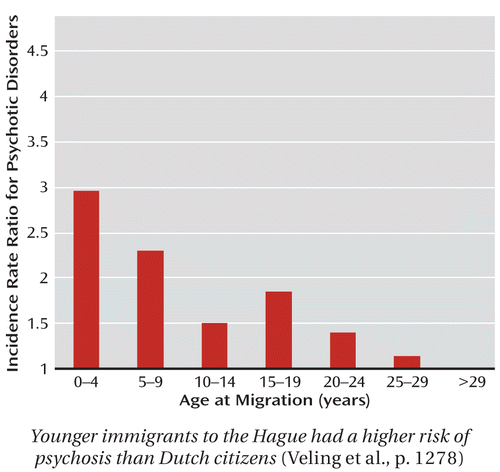In This Issue
Age at Migration and Risk of Psychosis
The risk of psychotic disorders is higher for non-Western immigrants to the Netherlands than for Dutch citizens but is inversely related to the age at migration. Veling et al. (p. Original article: 1278) found that the risk of psychotic disorders in the Hague was highest among those who migrated between ages 0 and 4, but in those who migrated after age 29 the risk was no higher than that for Dutch citizens. The rates were similar among the four largest ethnic groups. The data are based on municipal immigration records and on collaboration with general practitioners and psychiatrists to identify each initial contact with a physician for a possible psychotic disorder over 7 years. In their editorial, McGrath and Lawlor (p. Original article: 1235) describe how epidemiology can refine the search for candidate exposures influencing schizophrenia, and they point out the importance of separating proxy risk indicators from modifiable causal risk factors.

Younger immigrants to the Hague had a higher risk of psychosis than Dutch citizens (Veling et al., p. 1278)
Childhood Trauma and Psychosis
Patients with psychotic disorders reported more childhood trauma than their siblings, who in turn reported more trauma than unrelated healthy subjects. Heins et al. (CME, p. Original article: 1286) nevertheless found that emotional, physical, or general childhood abuse was related to adult occurrence of positive psychotic symptoms, such as hallucinations, in all three groups. Childhood emotional or physical neglect was largely unrelated to symptoms. The relationship between abuse and positive symptoms followed a dose-response pattern, with higher rates of childhood abuse in participants with higher levels of positive symptoms.
Impaired Fear Extinction: A Research Proxy for Anxiety Disorders?
The inability to extinguish fearful reactions is proposed by Graham and Milad (CME, p. Original article: 1255) as a focus for research on anxiety disorders. The arguments for concentrating on disrupted fear extinction, rather than specific diagnoses, include the likelihood that it underlies several anxiety disorders and the ability to manipulate and then assess it objectively. The brain circuitry associated with fear extinction involves interactions among the prefrontal cortex, amygdala, and hippocampus. Anxiety disorders are associated with deficiencies in this neural circuitry. Preliminary evidence suggests that the extinction model could be used to detect vulnerability to anxiety disorders and to predict treatment response. Rodents would be useful in research based on this model, as the neural structures involved in extinction in rodents and humans are similar.
Psychiatry Training for Rural Physicians in China
A brief educational program for 10,000 rural physicians in China introduced them to psychiatric knowledge and skills, emphasizing suicide risk assessment and management. The instruction outlined by Law et al. (p. Original article: 1249) occurred at 119 sites in 10 provinces over 2 weeks, more than half of which was spent in clerkship-style clinical training. Six months after the program, the physicians reported positive changes in their attitudes toward psychiatry, applicability of their new knowledge, and more communication with specialists. The success of the training has led to further mental health education initiatives in the participating provinces.
Clinical Guidance: Rating and Predicting Suicide Risk
The Columbia–Suicide Severity Rating Scale was initially designed to assess suicidal ideation and behavior in clinical trials. Psychometric analysis of data on adolescents by Posner et al. (p. Original article: 1266) indicated that a lifetime history of worst-point suicidal ideation including either suicidal intent or intent with a plan predicts a future risk of an actual attempt that is four times as great as the risk associated with a history of current suicidal ideation, including a desire to be dead, or increased general ratings of depression.



